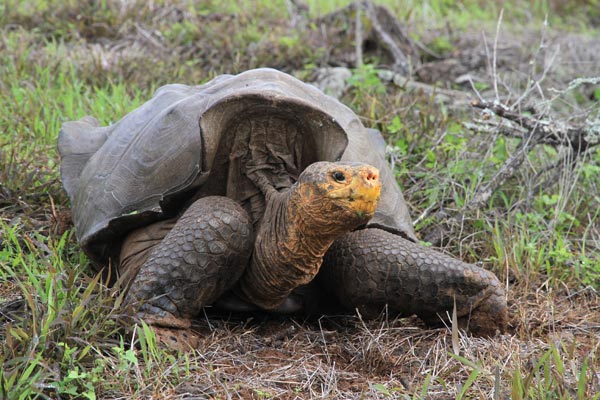Giant Tortoises Gain a Foothold on a Galapagos Island

James P. Gibbs, SUNY-ESF Giant tortoise on the Galapagos island of Española
A population of endangered giant tortoises, which once dwindled to just over a dozen, has recovered on the Galapagos island of Española, a finding described as “a true story of success and hope in conservation” by the lead author of a study published today (Oct. 28).
Some 40 years after the first captive-bred tortoises were reintroduced to the island by the Galapagos National Park Service, the endemic Española giant tortoises are reproducing and restoring some of the ecological damage caused by feral goats that were brought to the island in the late 19th century.
“The global population was down to just 15 tortoises by the 1960s. Now there are some 1,000 tortoises breeding on their own. The population is secure. It’s a rare example of how biologists and managers can collaborate to recover a species from the brink of extinction, ” said James P. Gibbs, a professor of vertebrate conservation biology at the SUNY College of Environmental Science and Forestry (ESF) and lead author of the paper published in the journal “PLOS ONE.”
Gibbs and his collaborators assessed the tortoise population using 40 years of data from tortoises marked and recaptured repeatedly for measurement and monitoring by members of the Galapagos National Park Service, Charles Darwin Foundation, and visiting scientists.
But there is another side to the success story: while the tortoise population is stable, it is not likely to increase until more of the landscape recovers from the damage inflicted by the now-eradicated goats.
“Population restoration is one thing but ecological restoration is going to take a lot longer,” Gibbs said.
After the goats devoured all the grassy vegetation and were subsequently removed from the island, more shrubs and small trees have grown on Española. This hinders both the growth of cactus, which is a vital piece of a tortoise’s diet, and the tortoises’ movement. Chemical analysis of the soil, done by Dr. Mark Teece, an ESF chemistry professor, shows there has been a pronounced shift from grasses to woody plants on the island in the last 100 years.
The shrubs and trees also inhibit the movements of the endangered waved albatross that breeds on the island. Gibbs said the plants make it difficult for the ungainly sea birds to take flight.
“This is a miraculous conservation success accomplished by the Galapagos National Park Service,” said Gibbs, “ but there is yet more work to fully recover the ecosystem upon which the tortoises and other rare species depend.”
Gibbs’ co-authors on the study are Elizabeth A. Hunter, an ESF alumna who is now a Ph.D. student at the University of Georgia; Kevin T. Shoemaker, an ESF alumnus who is now a research scientist at SUNY’s Stony Brook University; Washington H. Tapia formerly of the Galapagos National Park Service; and Linda J. Cayot of the Galapagos Conservancy. The research was supported by the Galapagos National Park Service, the Galapagos Conservancy, the Prometeo Program of Ecuador’s National Secretariat for Higher Education, Science, Technology and Innovation, and the U.S. National Science Foundation.
Media Contact
More Information:
http://www.esf.eduAll latest news from the category: Ecology, The Environment and Conservation
This complex theme deals primarily with interactions between organisms and the environmental factors that impact them, but to a greater extent between individual inanimate environmental factors.
innovations-report offers informative reports and articles on topics such as climate protection, landscape conservation, ecological systems, wildlife and nature parks and ecosystem efficiency and balance.
Newest articles

Superradiant atoms could push the boundaries of how precisely time can be measured
Superradiant atoms can help us measure time more precisely than ever. In a new study, researchers from the University of Copenhagen present a new method for measuring the time interval,…

Ion thermoelectric conversion devices for near room temperature
The electrode sheet of the thermoelectric device consists of ionic hydrogel, which is sandwiched between the electrodes to form, and the Prussian blue on the electrode undergoes a redox reaction…

Zap Energy achieves 37-million-degree temperatures in a compact device
New publication reports record electron temperatures for a small-scale, sheared-flow-stabilized Z-pinch fusion device. In the nine decades since humans first produced fusion reactions, only a few fusion technologies have demonstrated…





















